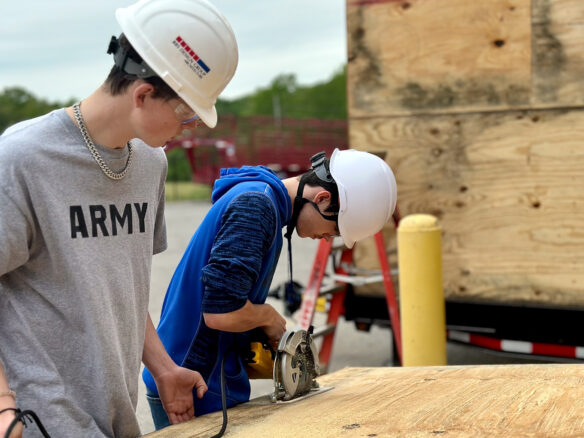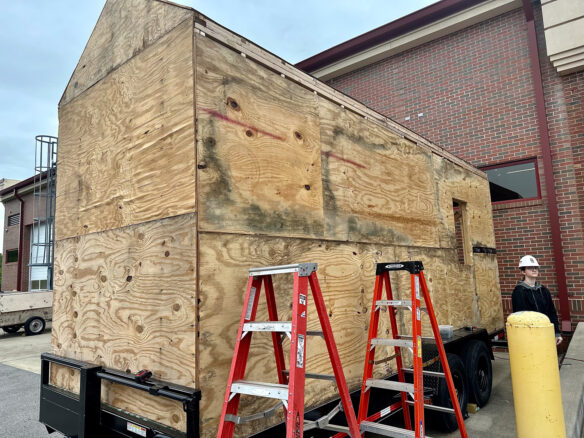
CTE empowers Kentucky’s future workforce as they learn skills and trades. A tiny house built by students in Barren County is one example of CTE’s real-world application. Photo by Wallace Caleb Bates, April 27, 2023
Barren County is like many rural areas throughout the Commonwealth of Kentucky: a close-knit community with a trades-based economy. Recognizing this, community leaders, including fiscal court officials, came together with a task for Barren County Area Technology Center students.
The automotive, carpentry, electricity, heating, cooling and ventilation (HVAC), plumbing and welding students are collaborating on a community-based project to provide housing for those in need: a tiny house that will feature a kitchen, sleeping area, sitting area, bathroom and more. Each element that goes into creating a comfortable living space requires each program’s expertise.
Career and technical education (CTE), often executed by Kentucky Tech staff in Kentucky’s 51 state-run facilities like Barren County ATC, meets students’ academic achievement, career exploration, career preparation and leadership development needs and empowers students to transition to postsecondary life. The project is one among many efforts to provide high-quality, rigorous CTE for students at Barren County ATC.
“When we were approached with this project, we were trying to tie in as many areas as possible. We had construction technology to do the construction of the home. HVAC will be doing the heating and cooling, a ductless mini split. We have electrical tied-in there as well,” said Jonathan Myatt, an instructor at Barren County ATC. “We’re going to include as many programs as possible.”
When natural disaster struck in 2021 in western Kentucky, including communities just 30 minutes west of Barren County, students saw families leaving their properties for hotel rooms in Paducah and other distant cities. One of the goals of the tiny house project focuses on keeping victims in such times of tragedy close to home – on their own property, even.
“The whole intention of this project is for people who have lost their homes or are unable to be in their homes,” Sam Estes, a senior, said. “We could take [the tiny house] and park it in front of their house, or on their property or somewhere where they can live and still be situated until their problem gets solved.”
The project’s timeline transcends this academic year, so seniors leave a legacy of building the foundational structure for the tiny house.
“I think it’s good for the community. It’s a house for if somebody needs it, we’ll have it ready for them,” said Preston Wells, a senior at Barren County High School. “I hope it helps somebody. Even if I’m not here to see it finished, I’m glad that I was able to at least start it.”

Barren County ATC’s tiny house is parked outside the main facility, allowing close proximity for students working on the house. Many ATC pathways are partnering to frame walls and install electricity and plumbing. Photo by Wallace Caleb Bates, April 27, 2023
The tiny house sits on a trailer parked behind the ATC for easy access, allowing programs to work on it without commuting long distances. The tiny house will create a semblance of home in areas across the county, depending upon where people’s needs arise.
“The project being here on-campus, at the school, allows for more time to be spent on the project with several programs involved. It eliminates travel time going to the site to work,” said Ashley Burd, who is in her 13th year as principal at Barren County ATC.
During her career, Burd has focused on connecting content with real-world situations through hands-on applications. She explained that classroom lessons relate directly to the tiny house’s construction.
“Our students are taught the program of studies for each of the classes they’re taking: the floor and wall framing, the plumbing classes, the HVAC classes,” she said. “Everyone that’s involved starts learning those concepts, ideas, vocabulary and how those concepts work together.”
The project focuses on traditional content found in ATC courses, but it also aims to teach aspiring tradespeople about the importance of using their skills to help others.
“Learning how to give back to the community and seeing what’s out there to help within the community,” Brandon Jones, a sixth-semester student in the carpentry program, said about the lessons the project is teaching him for his future. “I would like to go into carpentry.”
Jones’ acknowledgment of lessons learned exemplifies Myatt’s goal.
“Ultimately, we want to prepare these students for when they graduate,” Myatt said of teaching students a trade. “This gives our kids the opportunity to give back.”
Burd said the project goes beyond the ATC and its teachings, even beyond the students themselves.
“It allows students to be a part of something bigger than themselves,” Burd said. “They get to see that sense of ‘I’m doing this not only for my class but for the community.'”




Leave A Comment